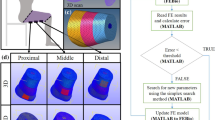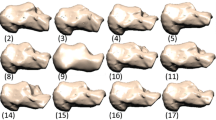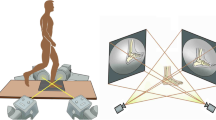Abstract
Patients with a spinal cord injury (SCI) are susceptible to deep tissue injury (DTI), a necrosis in excessively deformed muscle tissue overlying bony prominences, which, in wheelchair users, typically occurs in the gluteus muscles under the ischial tuberosities. Recently, we developed a generic real-time, subject-specific finite element (FE) modeling method to provide monitoring of mechanical conditions in deep tissues deformed between bony prominences and external surfaces. We previously employed this method to study internal tissue loads in plantar tissues of the foot [Yarnitzky, G., Z. Yizhar, and A. Gefen. J. Biomech. 39:2673–2689, 2006] and in muscle flaps of residual limbs in patients who underwent transtibial amputation (Portnoy, S., G. Yarnitzky, Z. Yizhar, A. Kristal, U. Oppenheim, I. Siev-Ner, and A. Gefen. Ann. Biomed. Eng. 35:120–135, 2007). The goal of the present study was to adapt the method to study the time-dependent mechanical stresses in glutei of patients with SCI during wheelchair sitting, continuously in real-time, and to compare the trends of internal tissue load data with those of controls. Prior to human studies, the real-time FE model—adapted to study the buttocks during sitting—was validated by comparing its predictions to data from a physical phantom of a buttocks and to non-real-time, commercial FE software. Next, real-time, subject-specific, FE models were built for six participating subjects (3 patients with SCI, 3 controls) based on their individual anatomies from MRI scans. Subjects were asked to sit normally in a wheelchair, on a ROHO cushion, and to watch a 90 min movie. Continuous interface pressure measurements from a pressure mat were used as subject-specific boundary conditions for real-time FE analyses of deep muscle stresses. Highest peaks of compression, shear and von Mises stresses throughout the trial period, and averages of peaks of these stresses were recorded over the trial for each individual. These parameters generally had 3-times to 5-times greater values in patients with SCI compared with controls. Likewise, stress doses, defined as the integration of peak compression stress over time, were ∼35-times and ∼50-times greater in the subjects with SCI, the values referring to the highest of all peaks recorded throughout the trial, and to average of peaks over the trial, respectively. We believe that by allowing—for the first time—practical and continuous monitoring of internal tissue loads in patients with motosensory deficits, without any risk or interruption to their lifestyle, and either at the clinical setting or at home, the present method can make a substantial contribution to the prevention of severe pressure ulcers and DTI.









Similar content being viewed by others
References
Agam L., A. Gefen 2007 Pressure ulcers and deep tissue injury: a bioengineering perspective. J. Wound Care 16:336–342
Agam L., A. Gefen 2008 Toward real-time detection of the risk for a deep tissue injury in wheelchair users using the Hertz contact theory. J. Rehabil. Res. Dev. 45:537–550
Berkley J., G. Turkiyyah, D. Berg, M. Ganter, S. Weghorst 2004 Real-time finite element modeling for surgery simulation: An application to virtual suturing. IEEE T. Vis. Comput. Gr. 10:314–325. doi:10.1109/TVCG.2004.1272730
Berlowitz D. R., D. M. Brienza 2007 Are all pressure ulcers the result of deep tissue injury? A review of the literature. Osto. Wound Man. 53:34–38
Black, J. Deep tissue injury: state of the science. In: 10th European Pressure Ulcer Advisory Panel Open Meeting, Oxford, UK, August 30–September 1, 2007.
Black J. M. 2005 The National Pressure Ulcer Advisory Panel. Moving towards consensus on deep tissue injury and pressure ulcer staging. Adv. Skin Wound Care 18:415–421. doi:10.1097/00129334-200510000-00008
Black J., M. Baharestani, J. Cuddigan, B. Dorner, L. Edsberg, D. Langemo, M. E. Posthauer, C. Ratliff, G. Taler 2007 National Pressure Ulcer Advisory Panel. National Pressure Ulcer Advisory Panel’s updated pressure ulcer staging system. Dermatol. Nurs. 19:343–349
Bland J. M., D. G. Altman 1986 Statistical methods for assessing agreement between two methods of clinical measurement. Lancet i: 307–310
Bliss M. R. 1992 Acute pressure area care: Sir James Paget’s legacy. Lancet 339:221–223. doi:10.1016/0140-6736(92)90016-V
Brosh T., M. Arcan 2000 Modeling the body/chair interaction—an integrative experimental-numerical approach. Clin. Biomech. 15: 217–219. doi:10.1016/S0268-0033(99)00073-X
Drerup B., S. Kraneburg, A. Koller 2001 Visualisation of pressure dose: Synopsis of peak pressure, mean pressure, loading time and pressure time-integral. Clin. Biomech. 16:833–834
Ferrarin M., G. Andreoni, A. Pedotti 2000 Comparative biomechanical evaluation of different wheelchair seat cushions. J. Rehabil. Res. Dev. 37:315–324
Gawlitta D., W. Li, C. W. Oomens, F. P. Baaijens, D. L. Bader, C. V. Bouten 2007 The relative contributions of compression and hypoxia to development of muscle tissue damage: an in vitro study. Ann Biomed Eng. 35:273–284. doi:10.1007/s10439-006-9222-5
Gefen A. 2007 The biomechanics of sitting-acquired pressure ulcers in patients with spinal cord injury or lesions. Int. Wound J. 4:222–231. doi:10.1111/j.1742-481X.2007.00330.x
Gefen A., L. H. Cornelissen, D. Gawlitta, D. L. Bader, C. W. Oomens 2008a The free diffusion of macromolecules in tissue-engineered skeletal muscle subjected to large compression strains. J. Biomech. 41:845–853. doi:10.1016/j.jbiomech.2007.10.023
Gefen A., N. Gefen, E. Linder-Ganz, S. S. Margulies 2005 In vivo muscle stiffening under bone compression promotes deep pressure sores. J. Biomech. Eng. 127:512–524. doi:10.1115/1.1894386
Gefen A., J. Levine 2007 The false premise in measuring body-support interface pressures for preventing serious pressure ulcers. J. Med. Eng. Tech. 31:375–380. doi:10.1080/03091900601165256
Gefen A., B. van Nierop, D. L. Bader, C. W. Oomens 2008b Strain-time cell-death threshold for skeletal muscle in a tissue-engineered model system for deep tissue injury. J Biomech. 41:2003–2012. doi:10.1016/j.jbiomech.2008.03.039
Gilsdorf P., R. Patterson, S. Fisher 1991 Thirty-minute continuous sitting force measurements with different support surfaces in the spinal cord injured and able-bodied. J. Rehabil. Res. Dev. 28:33–38. doi:10.1682/JRRD.1991.10.0033
Hamanami K., A. Tokuhiro, H. Inoue 2004 Finding the optimal setting of inflated air pressure for a multi-cell air cushion for wheelchair patients with spinal cord injury. Acta. Med. Okayama 58:37–44
Levi B., R. Rees 2007 Diagnosis and management of pressure ulcers. Clin Plast Surg. 34:735–748. doi:10.1016/j.cps.2007.07.007
Linder-Ganz E., S. Engelberg, M. Scheinowitz, A. Gefen 2006 Pressure-time cell death threshold for albino rat skeletal muscles as related to pressure sore biomechanics. J. Biomech. 39:2725–2732. doi:10.1016/j.jbiomech.2005.08.010
Linder-Ganz E., A. Gefen 2004 Mechanical compression-induced pressure sores in rat hind-limb: muscle stiffness, histology and computational models. J. Appl. Physiol. 96:2034–2049. doi:10.1152/japplphysiol.00888.2003
Linder-Ganz E., M. Scheinowitz, Z. Yizhar, S.S. Margulies, A. Gefen 2007 How do normals move during prolonged wheelchair-sitting? Technol Health Care 15: 195–202
Linder-Ganz E., N. Shabshin, Y. Itzchak, A. Gefen 2007 Assessment of mechanical conditions in sub-dermal tissues during sitting: a combined experimental-MRI and finite element approach. J Biomech. 40:1443–1454. doi:10.1016/j.jbiomech.2006.06.020
Linder-Ganz E., N. Shabshin, Y. Itzchak, Z. Yizhar, I. Siev-Ner, A. Gefen 2008 Strains and stresses in sub-dermal tissues of the buttocks are greater in paraplegics than in healthy during sitting. J Biomech. 41:567–580. doi:10.1016/j.jbiomech.2007.10.011
Margolis D. J., J. Knauss, W. Bilker, M. Baumgarten 2003 Medical conditions as risk factors for pressure ulcers in an outpatient setting. Age Ageing 32:259–264. doi:10.1093/ageing/32.3.259
Merbitz C. T., R. B. King, J. Bleiberg, J. C. Grip 1985 Wheelchair push-ups: measuring pressure relief frequency. Arch. Phys. Med. Rehabil. 66:433–438
Ohura T., N. Ohura, H. Oka 2007 Incidence and clinical symptoms of hourglass and sandwich-shaped tissue necrosis in stage IV pressure ulcers. Wounds 19:310–319
Oomens C. W., O. F. Bressers, E. M. Bosboom, C. V. Bouten, D. L. Bader 2003 Can loaded interface characteristics influence strain distributions in muscle adjacent to bony prominences? Comput. Met. Biomech. Biomed. Eng. 6:171–180. doi:10.1080/1025584031000121034
Palevski A., I. Glaich, S. Portnoy, E. Linder-Ganz, A. Gefen 2006 Stress relaxation of porcine gluteus muscle subjected to sudden transverse deformation as related to pressure sore modeling. J. Biomech. Eng. 128: 782–787. doi:10.1115/1.2264395
Patterson R. P., S. V. Fisher 1980 Pressure and temperature patterns under ischial tuberosities. Bull. Prosthet. Res. 17:5–11
Portnoy S., G. Yarnitzky, Z. Yizhar, A. Kristal, U. Oppenheim, I. Siev-Ner, A. Gefen 2007 Real-time patient-specific finite element analysis of internal stresses in the soft tissues of a residual limb: a new tool for prosthetic fitting. Ann. Biomed. Eng. 35:120–135. doi:10.1007/s10439-006-9208-3
Ragan R., T. W. Kernozek, M. Bidar, J. W. Matheson 2002 Seat-interface pressures on various thicknesses of foam wheelchair cushions: a finite modeling approach. Arch. Phys. Med. Rehabil. 83:872–875. doi:10.1053/apmr.2002.32677
Salcido R. 2006 What is the “purple heel”? Adv. Skin Wound Care 19:11
Shirado O., M. Kawase, A. Minami, T. E. Strax 2004 Quantitative evaluation of long sitting in paraplegic patients with spinal cord injury. Arch. Phys. Med. Rehabil. 85:1251–1256. doi:10.1016/j.apmr.2003.09.014
Stekelenburg A., C. W. Oomens, G. J. Strijkers, K. Nicolay, D. L. Bader 2006 Compression-induced deep tissue injury examined with magnetic resonance imaging and histology. J. Appl. Physiol. 100:1946–1954. doi:10.1152/japplphysiol.00889.2005
Stekelenburg A., G. J. Strijkers, H. Parusel, D. L. Bader, K. Nicolay, C. W. Oomens 2007 Role of ischemia and deformation in the onset of compression-induced deep tissue injury: MRI-based studies in a rat model. J Appl Physiol. 102:2002–2011. doi:10.1152/japplphysiol.01115.2006
Stockton L., D. Parker 2002 Pressure relief behavior and the prevention of pressure ulcers in wheelchair users in the community. J. Tissue. Viability 12:84–92
Tam E. W., A. F. Mak, W. N. Lam, J. H. Evans, Y. Y. Chow 2003 Pelvic movement and interface pressure distribution during manual wheelchair propulsion. Arch. Phys. Med. Rehabil. 84:1466–1472. doi:10.1016/S0003-9993(03)00269-7
Temes W. C., P. Harder 1977 Pressure relief training device. Phys. Ther. 57:1152–1153
Thomas, D. R. Prevention and treatment of pressure ulcers: what works? What doesn’t? Cleve. Clin. J. Med. 68:704–707, 10–14, 17–22, 2001.
Tsokos M., A. Heinemann, K. Puschel 2000 Pressure sores: epidemiology, medico-legal implications and forensic argumentation concerning causality. Int. J. Legal. Med. 113:283–287. doi:10.1007/s004149900125
Verver M. M., J. van Hoof, C. W. Oomens, J. S. Wismans, F. P. Baaijens 2004 A finite element model of the human buttocks for prediction of seat pressure distributions. Comput. Met. Biomech. Biomed. Eng. 7:193–203. doi:10.1080/10255840410001727832
Wagnac E. L., C. E. Aubin, J. Dansereau 2008 A new method to generate a patient-specific finite element model of the human buttocks. IEEE Trans. Biomed. Eng. 55:774–783. doi:10.1109/TBME.2007.912640
Wey P. D., L. A. Casas, V. L. Lewis Jr 1990 Buried inferiorly based gluteus maximus musculocutaneous flap for reconstruction of large, recurrent ischiopubic pressure sores. Ann Plast Surg. 24:283–288. doi:10.1097/00000637-199003000-00016
Yarnitzky G., Z. Yizhar, A. Gefen 2006 Real-time subject-specific monitoring of internal deformations and stresses in the soft tissues of the foot: A new approach in gait analysis. J. Biomech. 39:2673–2689. doi:10.1016/j.jbiomech.2005.08.021
Acknowledgments
We appreciate the help of Mr. Boaz Samir from ‘‘Zeadim’’ Daily Rehabilitation Center, Ramat-Gan, Israel, for his help in recruiting volunteers for this study. Ms. Sigal Portnoy, a doctoral student in the Musculoskeletal Biomechanics Laboratory (AG), Tel Aviv University, is thanked for her help in data analyses.
Author information
Authors and Affiliations
Corresponding author
Rights and permissions
About this article
Cite this article
Linder-Ganz, E., Yarnitzky, G., Yizhar, Z. et al. Real-Time Finite Element Monitoring of Sub-Dermal Tissue Stresses in Individuals with Spinal Cord Injury: Toward Prevention of Pressure Ulcers. Ann Biomed Eng 37, 387–400 (2009). https://doi.org/10.1007/s10439-008-9607-8
Received:
Accepted:
Published:
Issue Date:
DOI: https://doi.org/10.1007/s10439-008-9607-8




